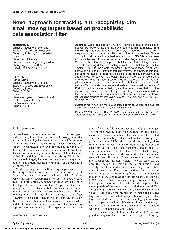摘要
While tracking dim and small moving targets in the electro-optical (EO) tracking system, the numerous false alarms resulted from the low signal-to-noise ratio would seriously debase the performance of target recognition and tracking. The probabilistic data association filter in conjunction with a maximum likelihood approach (PDAF-ML) has been applied effectively to low observable or dim target motion analysis. Whereas, the PDAF-ML supposes that the amplitude of target is not correlative among different sampling instants, and that the greater the amplitude value is, the greater the probability of being the target of interest would be. In the EO imaging tracking system, the amplitude information and the motion of target are consistent and highly correlative in a short period. To resolve the problem that the PDAF-ML is inconsistent with the EO imaging tracking system, the two features, namely, the amplitude information and the motion as well as their consistency, are modeled as Markov stationary random signals and are fused by means of PDAF. Experiments are carried out, and the results show that, with the proposed approach, the uncertainty of trajectory association would be largely decreased, and the performance of target recognition and tracking could be significantly improved.
- 出版日期2007-1
- 单位中国科学院光电技术研究所; 重庆大学; 中国空气动力研究与发展中心
